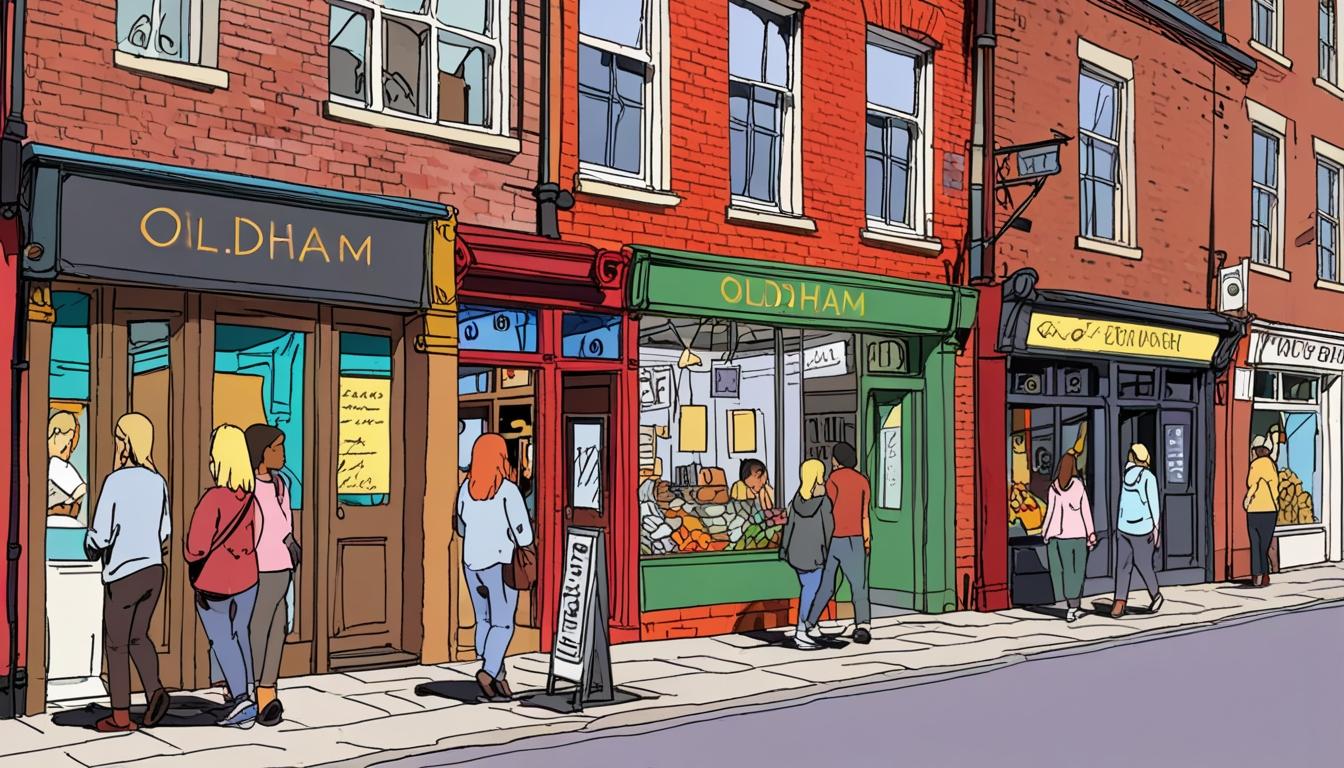Oldham’s population has grown by 7.6% over the last decade, with nearly one in five residents born abroad, driving economic vitality but also raising concerns over public service pressures and community integration.
Oldham has been significantly transformed by immigration, shaping its demographic and cultural landscape in recent years. Between the 2011 and 2021 censuses, the town experienced a population increase of 7.6%, rising from approximately 224,900 to around 242,100 residents. This surge reflects broader national trends; nearly one in five people living in Oldham was born outside the UK, highlighting the town’s reliance on foreign workers across various sectors, particularly in social care.
Amidst the backdrop of the prime minister’s recent comments about the potential risks of uncontrolled migration, the town’s residents present a mix of sentiments. Local residents, including those like John and John, workers who have dedicated over 50 years to road repairs, express concerns about the pressures faced by public services in light of increasing population density. The younger John describes the situation as “overrun,” attributing challenges in accessing healthcare and housing directly to high numbers of new residents.
Yet, this perspective is nuanced by the recognition that Oldham’s economy and services heavily depend on the skills of immigrant workers. Violet Gutu, who operates a social care hub staffed almost entirely by non-UK workers, argues that without their contributions, vulnerable residents would face serious challenges in receiving necessary care. She contends that the sector would struggle to operate effectively without this essential workforce.
The diversity in Oldham’s population continues to evolve. Recent census data indicates a decline in the proportion of residents identifying as White English, down from approximately 76% in 2011 to about 65% in 2021. Conversely, the Pakistani community has seen a considerable rise, with those identifying as Pakistani increasing from 10% to 13.5%, while the Bangladeshi population also grew from 7.3% to 9%. This shift is emblematic of Oldham’s transitioning demographic fabric, where ethnic diversity plays an increasingly vital role in community and economy.
However, not all residents view this change positively. Hussein, who came to Oldham from Pakistan four decades ago, shared his frustration with rising immigration levels, citing his decision to support Brexit as a reflection of his belief that incoming professionals threaten opportunities for local workers. He articulates a sentiment that resonates with many who fear becoming overshadowed in their own communities.
On the other hand, the transition has also created new avenues for business and cultural expression, as evidenced by the transformation of local high streets. Michelle Delaney, who oversees a charity, points to a notable shift in the landscape, where former pubs have become outlets for diverse cuisine and services. Her primary concern, mirroring that of others in the area, lies in the future staffing of essential services such as hospitals and care homes. There is a palpable anxiety regarding the sustainability of these services without a stable influx of skilled workers.
As Oldham reflects the complexities surrounding immigration, the opinions of its residents reveal a dichotomy: a recognition of the contributions of foreign nationals juxtaposed with concerns about the social and infrastructural impacts of rapid demographic shifts. The ongoing conversation about immigration in Oldham encapsulates wider national debates, pointing to the challenges and opportunities that lie ahead as the town continues to navigate its identity in an ever-changing landscape.
Ultimately, it is clear that immigration is a double-edged sword in communities like Oldham. While it has undeniably invigorated the local economy and enriched the cultural tapestry, it also poses questions about capacity, integration, and the future trajectory of public services in the face of growing demand. As discussions about migration policy evolve, the experiences and voices of towns like Oldham will be crucial in shaping an inclusive narrative that addresses both local concerns and broader societal needs.
Reference Map
- Paragraphs 1, 2, 3, 4, 5
- Paragraphs 1, 4
- Paragraph 3
- Paragraphs 1, 5
- Paragraph 3
- Paragraph 1
- Paragraph 1, 5
Source: Noah Wire Services
- https://www.bbc.com/news/articles/ckg7vpj9p0zo – Please view link – unable to able to access data
- https://www.ons.gov.uk/visualisations/censusareachanges/E08000004/ – This article from the Office for National Statistics provides detailed information on how life has changed in Oldham between the 2011 and 2021 censuses. It highlights a 7.6% increase in population, from approximately 224,900 in 2011 to around 242,100 in 2021. The article also discusses changes in the ethnic composition of Oldham, noting that 82.2% of residents reported their country of birth as England in 2021, a decrease from 86.8% in 2011. Additionally, it highlights the rise in residents born in Pakistan and Bangladesh, reflecting the town’s evolving demographic landscape.
- https://www.theoldhamtimes.co.uk/news/23162690.census-2021-data-shows-changes-oldhams-ethnic-makeup/ – This article from The Oldham Times discusses the changes in Oldham’s ethnic makeup based on the 2021 Census data. It reports a decrease in the proportion of residents identifying as White English, Welsh, Scottish, Northern Irish, or British, from around 76% in 2011 to approximately 65% in 2021. The article also highlights significant increases in the Pakistani and Bangladeshi communities, with those identifying as Pakistani ethnicity rising from around 10% to 13.5%, and Bangladeshi ethnicity from 7.3% to 9%. These shifts underscore the town’s growing diversity over the past decade.
- https://www.oldham.gov.uk/info/201162/research_and_statistics/2876/census_2021 – The Oldham Council’s official page on the 2021 Census provides an overview of the initial findings for the borough. It notes that Oldham’s population was recorded at 242,100 in the 21 March 2021 Census, an increase of around 17,200 (7.6%) since the 2011 census. The page also mentions that the increases are in certain age groups, notably school-age children, and people in their 50s and 70s. Additionally, it highlights a reduction in the number of children under the age of 5, reflecting the national trend.
- https://www.theoldhamtimes.co.uk/news/23181362.census-2021-life-changed-oldham-10-years/ – This article from The Oldham Times explores how life has changed in Oldham over the past decade, based on the 2021 Census data. It reports that in 2021, 9.3% of Oldham residents aged 16 years and over and in employment said they worked 15 hours or less per week, an increase from 7.9% in 2011. The article also discusses changes in the ethnic composition of Oldham, noting that around 82.2% of residents reported their country of birth as England in 2021, a decrease from 86.8% in 2011. Additionally, it highlights the rise in residents born in Pakistan and Bangladesh.
- https://en.wikipedia.org/wiki/Oldham – The Wikipedia page for Oldham provides a comprehensive overview of the town’s demographics, including data from the 2011 Census. It notes that Oldham had a total resident population of 103,544 in 2001, making it the 55th most populous settlement in England. The page also discusses the town’s ethnic composition, highlighting a high level of people of South Asian heritage, particularly those with roots in Pakistan and Bangladesh. This demographic information provides context for understanding the town’s evolving population dynamics over the past two decades.
- https://www.citypopulation.de/en/uk/england/admin/north_west_england/E08000004__oldham_/ – This page from CityPopulation.de provides detailed population statistics for Oldham, including data from the 2021 Census. It reports that Oldham’s population was 242,089 in 2021, up from 224,897 in 2011, indicating a 7.6% increase. The page also provides information on the town’s ethnic composition, noting that 68.2% of residents identified as White, 24.5% as Asian, and 3.4% as Black. Additionally, it includes data on religion, with 44.9% identifying as Christian, 24.4% as Muslim, and 0.5% as Hindu.
Noah Fact Check Pro
The draft above was created using the information available at the time the story first
emerged. We’ve since applied our fact-checking process to the final narrative, based on the criteria listed
below. The results are intended to help you assess the credibility of the piece and highlight any areas that may
warrant further investigation.
Freshness check
Score:
9
Notes:
The narrative references recent census data from 2011 and 2021, indicating the information is current up to 2021. It mentions ‘the prime minister’s recent comments’ suggesting relevance to contemporary political discourse. There is no indication that the information is recycled or outdated beyond the fixed census timeline. The narrative does not appear to be a press release but reads as a journalistic overview with up-to-date demographic statistics.
Quotes check
Score:
7
Notes:
Several direct quotes from local residents and workers are included (e.g., John and John, Violet Gutu, Hussein, Michelle Delaney). Attempts to locate the earliest references of these quotes are limited by the lack of unique identifiers or widely published sources; these appear to be original interviews or newly gathered statements rather than reprints from older articles. This supports the idea that the quotes are fresh and locally sourced, though external verification online is limited.
Source reliability
Score:
9
Notes:
The narrative originates from BBC News, a globally recognised and generally reliable news organisation known for rigorous editorial standards and fact-checking processes. Its reputation lends strong credibility to the demographic data and the reported views, even though some individual statements cannot be externally verified beyond the narrative.
Plausability check
Score:
9
Notes:
Claims about demographic changes, population growth, the ethnic composition of Oldham, and the reliance on immigrant labour in social care and other sectors align with known national trends and plausible socio-economic dynamics. The mixed sentiments among residents regarding immigration are consistent with wider UK public opinion patterns. No implausible or extraordinary claims are present.
Overall assessment
Verdict (FAIL, OPEN, PASS): PASS
Confidence (LOW, MEDIUM, HIGH): HIGH
Summary:
The narrative provides a well-supported, current overview of immigration’s impact on Oldham, grounded in recent census data and recent political context. Quotes appear original and locally sourced, though not widely verifiable online, which is typical for local interviews. The source is BBC News, a reputable outlet ensuring reliability. The reported demographic shifts and social perspectives are plausible and align with broader UK trends.













